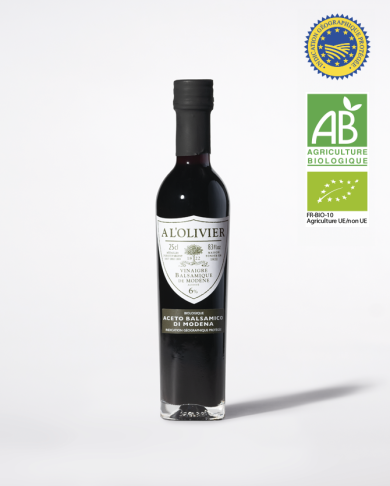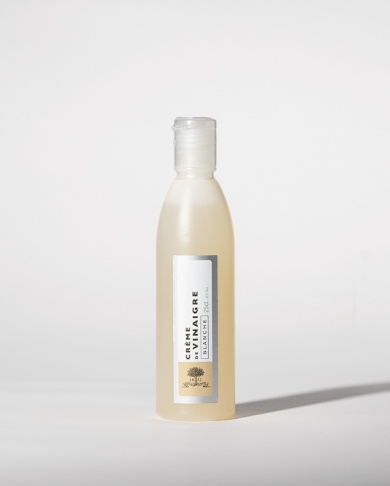INSPIRATIONS


Expert advice
| 17.09.2021
THE RIGHT VINEGAR FOR THE RIGHT DISH

There’s more than one type of vinegar! We’ll tell you everything you need to know in order to choose the right vinegar for your meal: fruit vinegar , wine vinegar, balsamic vinegar and more.
What is vinegar?
Essentially, vinegar is the result of fermenting red or white wine (or another alcoholic liquid) in the presence of oxygen. The term itself comes from the French “vin aigre”, meaning “sour wine”. Ethanol is converted to acetic acid through oxidation. Vinegar is therefore the product of alcoholic fermentation followed by acetic fermentation . Every part of the world has its own typical alcoholic beverages, so there’s a wide variety of vinegars with many levels of acidity, aromas, textures and colours.
Be aware that the percentage indicated on the label doesn’t correspond to the amount of alcohol in the vinegar or the drink from which it was made. In fact, it refers to the amount of acetic acid: the higher the percentage, the more acidic the taste.
Which vinegar should I choose?
Fruit vinegars: our favourites
Fruit vinegar is commonly defined as vinegar with added flavours or real fruit purée. Real fruit purée makes the tastiest vinegars: there’s a huge difference between the average raspberry vinegar, with or without natural flavourings, and our raspberry vinegar made with raspberry purée which is 40% fruit.
This technique allows us to create an original and intensely aromatic vinegar: lemon & grapefruit, fig, passion fruit, mango, tomato-basil, red bell pepper & Espelette chilli, beetroot & thyme… they’re a great way to add some extra flavour to your salads and deglaze meats like beef and duck. Their tart flavour also tastes great with fruity desserts. Try a few drops in a non-alcoholic cocktail—it changes everything!
Wine vinegar
Wine vinegar is popular in France. Some are manufactured quickly, within 24 hours, and are more acidic and less aromatic than homemade vinegars, which take time to produce. White wine vinegar (which is sometimes infused), is ideal with fish, seafood and white meat, and gives a delicious touch of acidity to a butter-based sauce. Red wine vinegar, which is stronger in taste, is tastes great in sauces, vinaigrettes or marinades for red meats.
Sherry vinegar
Sherry vinegar is made in Andalusia from Denominación de Origen (DO) white wines produced in Jerez de la Frontera. It’s aged in oak barrels for at least 6 months, with more prestigious sherry vinegars being aged for longer. It has a beautiful amber colour and a complex, powerful and woody aroma.
We make our sherry vinegar according to the traditional process using Oloroso sherry, which is made from sweet and mild Pedro Ximénez and Palomino grapes. It tastes delicious in salads and vinaigrettes, adds a pop of flavour to meats and even works well with desserts such as fruit salads (especially ones that include peaches) or vanilla ice cream.
Cider Vinegar
Mild, fruity and less acidic than wine vinegar, cider vinegar is widely used in French cuisine. This is a delicate vinegar which tastes great with a variety of foods and a in a number of recipes: seafood stews, marinated fish, mayonnaises that accompany shellfish, and salads that combine fruit and vegetable (e.g., apple and chicory), fruit chutneys, apple compotes...
Balsamic Vinegar
The best balsamic vinegars, produced in northern Italy, are protected by a PDO (Protected Designation of Origin) or a PGI (Protected Geographical Indication). The secret of this delicious vinegar is the cooked grape must and ageing process, which gives this vinegar a beautiful amber colour and a complex, syrupy character.
We offer many types of balsamic vinegar:
- Silver quality with 50% cooked grape must for gourmet cooking (deglazing foie gras or veal liver, a condiment for pairing with Parmesan cheese, or a finishing touch for strawberries or vanilla ice cream...).
- Bronze grade with 25% cooked grape must for everyday cooking (dressing salads, deglazing white meats or pan-fried figs...).
- With black truffle flavour, perfect for salads, celeriac soup or as a garnish for fried eggs.
- Available as a cream, perfect for decorating plates, binding sauces or flavouring a panna cotta.
- Also available in a spray bottle for subtle seasoning.
Rice vinegar
Made from rice spirits, rice vinegar is low in acidity. This popular Japanese vinegar, transparent to yellow in appearance, is perfect for seasoning sushi rice. It’s also a delicious way to make “instant” pickled vegetables. Japan also has red and black vinegars. Dark rice vinegars can be found in Korea and China, where black vinegar is favoured for its depth of flavour. You can find rice vinegar in Asian or organic grocery stores. It tastes great in traditional meals as well as exotic recipes!

 Menu
Menu
 Mon compte
Mon compte  Wishlist
Wishlist  Panier
Panier 



